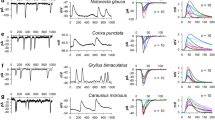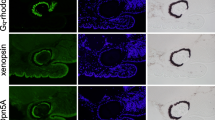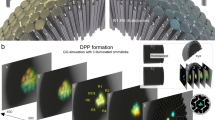Summary
This paper considers the functional significance of fused rhabdoms. Since all rhabdomeres are joined tightly together, the possibility of optical and electrical coupling between retinula cells is greatly enhanced. We study the extent and consequences of this coupling in order to understand the functional significance of fused rhabdoms. Our methods include both theory and intracellular recordings. The results are as follows:
Optical Coupling. Because rhabdomeres of different spectral types are fused into a common light guide, the absorption properties of each influence the manner in which light is transmitted along the composite rhabdom structure.
-
1.
Each rhabdomere acts as if it were an absorption filter in front of all others, i.e. rhabdomeres function as lateral absorption filters (Fig. 4).
-
2.
As a consequence of this filtering, the shape of the spectral sensitivity curve for each retinula cell is approximately independent of the amount of light it absorbs, i.e. independent of the rhabdomere's length and concentration of photopigment (Fig. 7). This is in direct contrast to the retinula cells of fly that have spectral sensitivity curves which become progressively flatter as more light is absorbed (Snyder and Pask, 1973). In other words, the flattening of curves by self absorption is prevented by optical coupling.
-
3.
Thus, one functional advantage of the fused rhabdom (due to optical coupling) is that each retinula cell can have a high absolute sensitivity while preserving its spectral identity (narrow spectral sensitivity curves). (Compare Fig. 5 to Fig. 6.) Thus the same receptors can operate in a high sensitivity and in a colour vision system (cf. vertebrate rods and cones).Since all spectral cell types are together in one rhabdom, the animal can have hue discrimination in a small field of view (fine grain colour vision). Thus an individual ommatidium has the potential for providing excellent spectral discrimination.
-
4.
If two cells have photopigments with absorption maxima close together, the maxima of their spectral sensitivity curves are moved further apart (Fig. 8).
-
5.
In the absence of electrical coupling polarization sensitivity (PS) can depend dramatically on wavelength. The spectral composition of the rhabdom, in addition to the direction of the microvilli, profoundly influences the polarization sensitivity vs. wavelength PS (λ) curves of individual retinula cells. This is shown theoretically for the worker bee rhabdom (Fig. 10) where (a) there is a pronounced difference in PS (λ) between cells with orthogonal microvilli and (b) green retinula cells show a large PS in the green while the UV cells show a much smaller PS in the UV (Fig. 13).
Similar content being viewed by others
References
Autrum, H., Zwehl, V. von: Die spektrale Empfindlichkeit einzelner Sehzellen des Bienenauges. Z. vergl. Physiol.48, 357–384 (1964)
Bullock, T. H., Horridge, G. A.: Structure and function in the nervous systems of invertebrates, vol. I and II. San Francisco-London: W. H. Freeman & Co. 1965
Burkhardt, D.: Colour discrimination in insects. Advanc. Insect Physiol.2, 131–174 (1964)
Butler, R.: The identification and map** of spectral cell types in the retina ofPeriplaneta america. Z. vergl. Physiol.72, 67–80 (1971)
Dartnall, H. J. A.: The interpretation of spectral sensitivity curves. Brit. med. Bull.9, 24–30 (1953)
Dartnall, H. J. A.: Photosensitivity. In: Handbook of sensory physiology, vol. VII/1. Photochemistry of vision, ed. H. J. A. Dartnall. Berlin-Heidelberg-New York: Springer 1972
Eakin, R. M.: Evolution of photoreceptors. Evol. Biol.2, 194–242 (1968)
Eakin, R. M.: Structure of invertebrate photoreceptors. In: Handbook of sensory physiology, ed. Dartnall, H. J. A., ch. 16. Berlin-Heidelberg-New York: Springer 1972 Vol. VII/1
Eguchi, E.: Fine structure and spectral sensitivities of retinula cells in the dorsal sector of compound eyes in the dragonflyAeschna. Z vergl. Physiol.71, 201–208 (1971)
Eguchi, E., Waterman, T. H., Akiyama, J.: Cellular basis of wavelength discrimination in the crayfishProcambarus. Amer. Zool.12, 252 (1972)
Frisch, K. von: The dance, language and orientation of bees. Cambridge, Mass.: Harvard University Press 1967
Furshpan, E. J., Potter, D. D.: Transmission at the giant motor synapses of the crayfish. J. Physiol. (Lond.)145, 289–325 (1959)
Gribakin, F. G.: Types of photoreceptor cells in the compound eye of the worker honey bee relative to their spectral sensitivity. Cytologia11, 309–314 (1969)
Gribakin, F. G.: The distribution of the long wave photoreceptors in the compound eye of the honey bee as revealed by selective osmic staining. Vision Res.12, 1225–1230 (1972)
Grundler, O. J.: Morphologische Untersuchungen am Bienenauge nach Bestrahlung mit Licht verschiedener Wellenlängen. Cytobiol.7, 105–110 (1973)
Hamdorf, K., Höglund, G., Langer, H.: Mikrophotometrische Untersuchungen an der Retinula des NachtschmetterlingsDeilephila elpenor. Verh. dtsch. zool. Ges.65, 276–280 (1972)
Helversen, O. von: Zur spektralen Unterschiedsempfindlichkeit der Honigbiene. J. comp. Physiol.80, 439–472 (1972)
Horridge, G. A.: Unit studies on the retina of dragonflies. Z. vergl. Physiol.62, 1–37 (1969)
Horridge, G. A.: Optical mechanism of clear zone eyes. In: The compound eye and vision of insects, ed. G. A. Horridge. In press (1973)
Kirschfeld, K.: The visual system ofMusca: Studies on optics, structure and function. Information Processing in the Visual Systems of Arthropods, ed. R. Wehner, p. 61–74. Berlin-Heidelberg-New York: Springer 1972
Laughlin, S. B.: Neural integration in the first optic neuropile of dragonflies: I. Signal amplification in a dark-adapted second order neuron. J. comp. Physiol.84, 338–358 (1973)
Locket, N. A.: Deep sea fish retinas. Brit. med. Bull.26, 107–111 (1970)
Menzel, R.: The fine structure of the compound eye ofFormica polyctena-Functional morphology of a hymenopteran eye. In: Information processing in the visual systems of arthropods, ed. R. Wehner, p. 37–49. Berlin-Heidelberg-New York: Springer 1972
Menzel, R.: Colour receptors in insects. In: The compound eye and vision of insects, ed. G. A. Horridge Oxford: University Press. In press (1973)
Miller, W. H., Snyder, A. W.: Optical function of human peripheral cones. In Press Vision Res. (1973)
Mote, M. I., Goldsmith, T. H.: Compound eyes: Localisation of two color receptors in the same ommatidium. Science171, 1254–1255 (1971)
Ninomiya, N., Tominaga, Y., Kuwabara, M.: The fine structure of the compound eye of a damsel-fly. Z. Zellforsch.98, 17–32 (1969)
Perrelet, A.: The fine structure of the retina of the honey bee drone. An electron microscopical study. Z. Zellforsch.108, 530–562 (1970)
Perrelet, A., Baumann, F.: Evidence for extracellular space in the rhabdome of the honey bee drone eye. J. Cell Biol.40, 825–830 (1969)
Scholes, J. H.: Discontinuity of the excitation process in locust visual cells. Cold Spr. Harb. Symp. quant. Biol.30, 517–527 (1965)
Shaw, S. R.: Interreceptor coupling in ommatidia of drone honey bee and locust compound eyes. Vision Res.9, 999–1030 (1969a)
Shaw, S. R.: Sense-cell structure and interspecies comparisons of polarized-light absorption in arthropod compound eye. Vision Res.9, 1031–1040 (1969b)
Snyder, A. W.: Polarization sensitivity of individual retinula cells. J. comp. Physiol.83, 331–360 (1973a)
Snyder, A. W.: Optical properties of invertebrate photoreceptors. In: The compound eye and vision of insects, ed. G. A. Horridge. Oxford: University Press. In press 1973b
Snyder, A. W., Pask, C.: Spectral sensitivity of dipteran retinula cells. J. comp. Physiol.84, 59–76 (1973)
Wald, G., Brown, P. K., Gibbons, I. R.: The problem of visual excitation. J. Opt. Soc. Am.53, 20–35 (1963)
Walcott, B.: Unit studies on receptor movements in the retina ofLethocerus (Belostomatidae, Hemiptera). Z. vergl. Physiol.74, 17–25 (1971)
Author information
Authors and Affiliations
Rights and permissions
About this article
Cite this article
Snyder, A.W., Menzel, R. & Laughlin, S.B. Structure and function of the fused rhabdom. J. Comp. Physiol. 87, 99–135 (1973). https://doi.org/10.1007/BF01352157
Received:
Issue Date:
DOI: https://doi.org/10.1007/BF01352157




